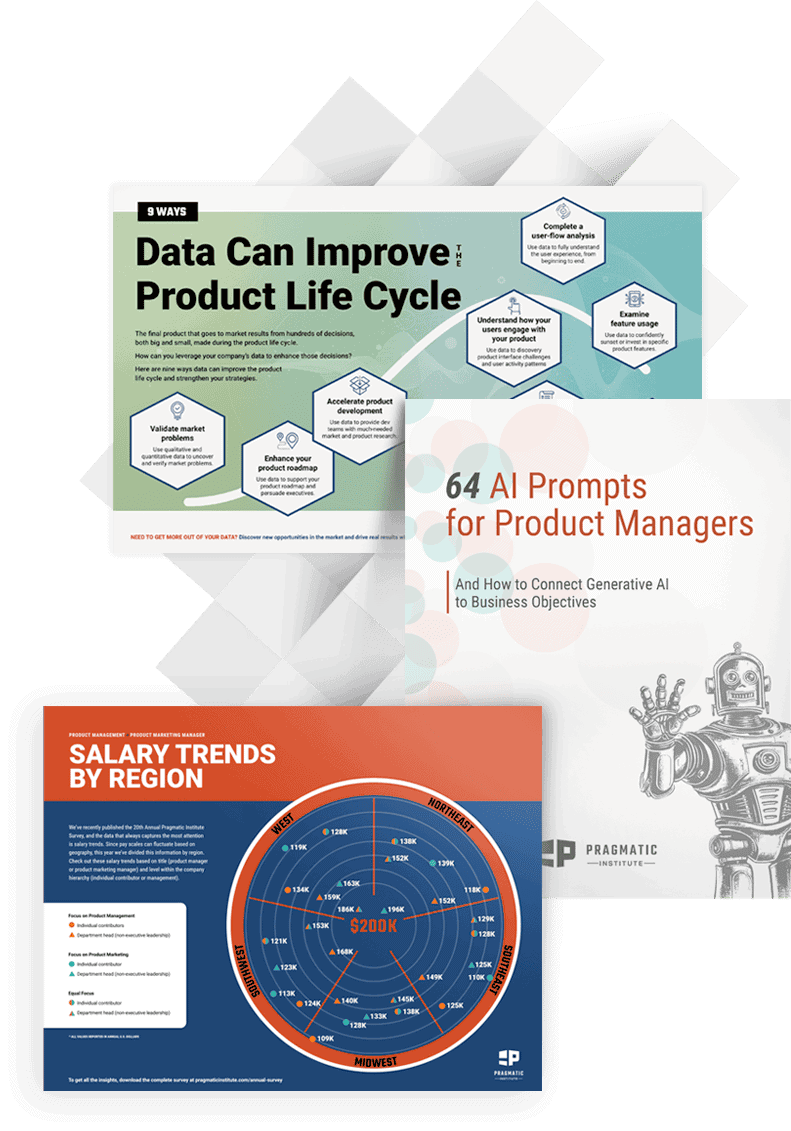8 minute read
The importance of AI for product managers continues to grow, making it critical to continuously expand and enhance your AI skills. This article offers an abundance of AI resources specifically curated for product managers.
You can’t watch the news or scroll social media without running across a story about Artificial Intelligence (AI). Since Chat GPT was unleashed on November 30th, 2022, by OpenAI, AI has entered just about every aspect of life. Now, there are hundreds of AI applications, including many that are integrated into the tools we use daily. Among these are AI tools that go far beyond the original concept of text generation, including sophisticated image and video generators.
The workplace, in particular, has seen a profound transformation since the introduction of AI. For product managers, AI has evolved from a curiosity to a critical tool that enhances decision-making and can accelerate development and innovation. Knowing how to leverage AI to be more effective in your role as a product manager isn’t a luxury, it is now a necessity.
The relevance of AI in product management has grown significantly and will continue to do so, making continued education in AI more crucial than ever. In this article, we will learn about the importance of AI in product management and methods to learn and grow your AI skills as a product manager.
Why AI Matters to Product Management
When Chat GPT first came out, it was seen as a novelty text generator more than anything else. Next, people grew to see AI as something useful in automating tasks. Now we recognize how powerful AI can be when properly utilized in the workplace. At this point, it has transformed how product managers approach everything from gathering customer feedback to making strategic product decisions.
By leveraging AI, product managers can harness vast amounts of data to gain deeper insights into customer behavior, market trends and potential opportunities. AI empowers product managers to be more data driven, which allows for more precise and informed decisions. Ultimately, this helps organizations create products that better meet customer needs while improving engagement and retention.
AI is also revolutionizing product development through automation. For instance, machine learning algorithms can analyze user feedback and historical data to optimize product features and even suggest high-value innovations. This not only accelerates the development process but also enhances the quality of the products being developed, reducing time-to-market and increasing the likelihood of sustained success.
All of this progress has happened in just a of couple years since the release of the first AI tool, marking the significance of AI in product management.
Why Product Managers Should Learn AI
Understanding and utilizing AI offers a significant competitive advantage to product managers. As AI continues to reshape industries, product managers who are proficient in AI can play a critical role in helping their organizations adopt these technologies effectively. This proficiency allows them to identify and implement AI-powered solutions that enhance decision-making, improve workflow, and lead to better, more data-informed products.
As AI becomes an integral part of product management tools and processes, product managers who are already adept in AI will be better equipped to lead AI-driven initiatives and cross-functional teams. Additionally, this type of knowledge and experience gives them a stronger competitive edge in the job market.
Rather than being just another tool, AI is a transformative force that redefines the role of product managers and expands their strategic influence. Product managers that understand this have an advantage over those that don’t.
Key Reasons Product Managers Should Learn AI
Enhance decision-making: AI enables data-driven insights that improve strategic choices
Optimize workflows: AI streamlines repetitive tasks, increasing efficiency
Drive product innovation: AI helps uncover new opportunities and feature enhancements
Improve user experiences: AI personalizes customer interactions and anticipates needs
Gain a competitive career advantage: AI proficiency makes product managers more valuable in the job market
Lead AI-driven initiatives: Understanding AI allows product managers to work effectively with data science and engineering teams
AI for Product Managers: The Basics
Harnessing the power of AI can be a game-changer, but getting started can be intimidating. There are countless AI applications and tools to choose from, which can make it overwhelming to determine where to begin.
So, how do you learn about this constantly evolving technology and apply it to your role? Let’s explore key AI concepts for product managers and how you can stay ahead in this rapidly changing landscape.
How Does AI Work?
AI uses complex algorithms and models to process large amounts of data, identify patterns, and make predictions or decisions based on that data. Machine learning, a subset of AI, enables systems to improve their performance over time by learning from past data without being explicitly programmed for every task. This is sometimes called “training,”and it takes a vast amount of data to train AI. This process is continuous, refining AI’s accuracy and adaptability as more data is introduced.
AI is broadly categorized into generative AI, which creates new content (such as text, images, and code), and predictive AI, which analyzes patterns in existing data to forecast trends and optimize decision-making. Product managers rely on both types, generative AI for ideation and automation, and predictive AI for insights that drive strategic planning.
On a more practical note, in some applications, AI simulates human intelligence to produce human-like results. For example, AI can assist product managers by analyzing customer feedback, predicting user behavior, and automating repetitive tasks. This is probably what comes to mind when you think of AI and tools like ChatGPT for writing documents or AI-powered design tools for generating images.
Looking at how ChatGPT works is a great way to better understand the connection between AI, machine learning, and practical applications for its use.
- ChatGPT utilizes a machine learning model known as a transformer neural network, specifically fine-tuned on a great amount of diverse text. This training allows it to process natural language inputs and generate contextually relevant responses.
- ChatGPT has a knack for simulating an understanding of the context of a conversation. In turn, it generates responses based on patterns learned during training. Although it does not truly understand meaning like a human does, it can provide highly relevant and context-aware responses based on probability models.
So when you ask ChatGPT a question, it can respond in a human-like way, using the vast amount of material it has been trained with to generate useful insights, summarize information, or assist with ideation.
Key Takeaways for Product Managers
- AI is not a single technology but a collection of methods, including machine learning, deep learning, and natural language processing.
- AI continuously improves through training, refining its ability to recognize patterns and generate insights.
- Product managers can use AI to analyze customer feedback, predict user behavior, automate reporting, and optimize decision-making.
- While AI tools like ChatGPT generate human-like responses, they do not “understand” content in the way humans do.
- AI can and does make mistakes. You must verify and guide every AI tool you use to ensure that the results are accurate and usable.
Available AI Tools
While we mention ChatGPT often because it is perhaps the most well-known, there are hundreds of AI tools currently available, each specializing in different areas. Here are some of the most widely used AI applications, categorized by their capabilities:
Text & Language AI (Chatbots, Writing, and Research)
ChatGPT: Conversational AI and content generation. Has a free plan with limitations.
Gemini: Google’s free AI for text and multimodal tasks. .
Claude: Free AI chatbot with deep contextual understanding. Has a free plan with limitations.
Perplexity AI: AI-powered search and research assistant. Has a free plan with limitations.
AI for PDFs, Documents, & Data Analysis
ChatPDF: AI for reading, summarizing, and analyzing PDFs. Has a free plan with limitations.
PDF.ai: Interactive AI-powered document analysis. Has a free plan with limitations.
Akkio: AI-driven predictive analytics for business intelligence.
AI Image Generation & Editing
Leonardo: AI-powered art and design tool. Has a free plan with limitations.
OpenArt: AI-generated artwork and creative assets. Has a free plan with limitations.
MidJourney: High-quality AI image generation. Currently by subscription.
Stable Diffusion: A free, open-source AI image generator.
DALL·E 3: AI-powered image creation by OpenAI. Has a free plan with limitations.
AI Video Generation & Editing
Runway Gen-2: AI-generated video creation. Has a free plan with limitations.
Synthesia: AI-powered video creation with avatars. Has a free plan with limitations.
Pika Labs: AI-based video editing and enhancement. Has a free plan with limitations.
Kaiber: AI video animation and transformation. Has a free plan with limitations.
Basic AI Terminology for Product Managers
As you begin learning about AI, you’ll encounter a variety of new concepts and terminology. While it’s impossible to cover everything in one place, familiarizing yourself with the following key AI terms will provide a solid foundation and help you navigate this fascinating field with greater confidence.
Artificial Intelligence Ethics: The branch of AI that is concerned with AI systems and their ethical implications. This includes issues like bias, fairness, accountability, data privacy, and the societal impacts of AI technology.
Deep Learning: A subset of machine learning that uses neural networks with multiple layers, enabling the system to learn complex patterns. These “deep” layers allow deep learning to tackle problems that require cognitive-like processing, making it effective for solving tasks that involve advanced pattern recognition.
General AI: Refers to AI that can understand, learn, and then apply knowledge across a large range of tasks. Essentially, general AI would be able to perform the same intellectual tasks that humans can. This remains theoretical, however, as current AI is still classified as narrow AI.
Machine Learning (ML): A subset of AI where machines access data and use it to learn independently. Machine learning models improve their performance over time by identifying patterns and making predictions based on past data.
Narrow AI: AI that is only trained to perform a specific task, like AI that only acts as an image recognition system or a voice assistant. All current AI systems, including ChatGPT and Siri, fall under this category.
Natural Language Processing (NLP): A branch of AI focused on enabling computers to interact with humans through natural language. Its goal is to read, interpret, and understand human language in a meaningful way. NLP powers tools like chatbots, voice assistants, and AI-based text analysis.
Neural Networks: A computational model inspired by the structure of the human brain. Neural networks power deep learning systems and are used in tasks such as image recognition, speech processing, and recommendation engines.
Reinforcement Learning: A type of machine learning where an AI model learns through trial and error, receiving rewards for successful actions. This method is often used in robotics, self-driving cars, and game-playing AI.
AI Model Fine-Tuning: The process of training a pre-existing AI model on specific datasets to improve performance for a specialized task. Product managers may fine-tune AI models for unique business needs.
Generative AI: AI that creates new content, such as text, images, audio, or video, based on training data. ChatGPT, MidJourney, and Runway Gen-2 are examples of generative AI tools.
Predictive AI: AI that analyzes patterns in historical data to forecast trends, anticipate outcomes, and optimize decision-making. This type of AI is often used in recommendation systems, fraud detection, and customer behavior analysis.
Learning AI for Product Managers
Truly learning AI for use in your role as a product manager is a process. While mastering AI requires far more than a single article can offer, this guide will provide you with a learning plan to help you effectively build and grow your AI skills. Once you are comfortable with the basics, it is advisable to seek official professional development in the form of continued education.
How to Build Basic AI Skills
Learning the basics is the starting point of building your AI skills as a product manager. One of the most simple ways to do this is to dive into the topic and learn everything you can from easily available free sources like books and videos.
AI Videos: Videos are a great way to start learning more about AI since you can watch them in your free time and they don’t require a large time commitment. The following videos cover various AI topics, from how AI and machine learning are different to tips for making better prompts.
- AI vs ML
- ChatGPT Tutorial
- How to Use Gemini
- Ultimate Guide to Using Claude 2025
- Ultimate Midjourney Guide 2025
- Master ChatGPT Prompts
- How to use DALL.E 3
- 5 Ways AI is Making You a Better Product Manager
- 5 Powerful AI Tools Every Product Manager Should be Using
- AI/ML Fundamentals for Product Managers
AI Books, Blogs and Forums: AI-related books and blogs let you tailor your learning to topics that are most interesting and helpful to you. You can find books on broad and general topics like the history of AI or very specific topics, like prompt engineering or using AI for product management. Forums are unique in that they allow you to ask questions, listen in on conversations and learn from others.
- AI Made Simple (Book)
- AI Leadership Handbook (Book)
- AI for Product Managers: Practical Handbook for Mastering AI and ML in your Role (Book)
- Product Managers Playbook for Generative AI (Free eBook)
- The AI-Powered Product Manager (Book)
- The AI Blog (Blog)
- AI Time Journal (Blog)
- Google AI (Blog)
- AI Forum Hub (Forum)
- R/Artificial (Reddit forum)
Hands-On AI Practice for Product Managers
Experimenting with AI tools is a great way to gain practical experience. It gives you the opportunity to play with AI tools at your own pace and tailor your experimentation around areas that are most applicable to your goals. The possibilities are just about limitless, but here are a few ideas to get you started. Just remember to always follow your company’s policies when sharing data with any AI tool. When in doubt, ask your leader before putting any information that isn’t available publicly on your company’s website into any AI tool.
Exercise A: Creating a Product FAQ with ChatGPT or a Similar Tool
Objective: Use ChatGPT or a similar tool to generate a comprehensive FAQ section for a hypothetical product.
Exercise: Start by inputting a prompt describing the product, its features, and potential customer queries. For example, “What are the key features of [product]?” or “How do I troubleshoot common issues with [product]?” The goal is to learn how to guide the AI tool in generating clear, concise, and accurate responses that could be used in a customer-facing FAQ.
Learning Outcome: This exercise helps you understand how to craft effective prompts to get useful, customer-oriented content, which is essential for product managers working on customer support or marketing materials.
Exercise B: Analyzing Customer Feedback Data
Objective: Use ChatGPT to analyze customer feedback data from an Excel spreadsheet and generate insights or summaries.
Upload data: Upload a CSV file with customer feed to ChatGPT. It should have columns like “Customer ID,” “Feedback Text,” “Rating (1-5),” and “Date of Feedback.”
Generate Prompts: Ask ChatGPT to summarize the key themes in the customer feedback. For example, “Analyze the feedback data and summarize the most common customer complaints.” Use prompts to generate insights, such as, “What are the top 3 areas of improvement based on the customer feedback?”
Refine the Output: If the initial output is too broad or misses key details, refine your prompts to ask for more specific insights. For example, “Based on the ratings, identify which feedback correlates with low customer satisfaction and explain why.”
Learning Outcome: This exercise helps you understand how to use ChatGPT with structured data. It teaches you how to craft prompts that effectively guide ChatGPT in generating summaries, extracting key insights and making data-driven decisions.
If you are not getting the response you expect, try changing some aspect of your prompt or the data you have offered and see how it alters the results. This approach can also be adapted for other types of data, such as sales figures, user engagement metrics, or survey results, making it a versatile tool for learning how to leverage AI in data analysis.
Additional Practical AI Exercises for Product Managers
The following exercises encourage you to leverage AI using real information to gain actionable insights you can implement right away.
AI-Powered Market Research & Competitive Analysis
- Exercise: Use AI to analyze industry trends and competitor positioning. Ask ChatGPT or Perplexity AI to summarize market reports and identify gaps in the competitive landscape.
AI in Data-Driven Decision-Making
- Exercise: Use AI-based analytics platforms like Akkio or Tableau to process product usage data and predict feature success rates.
AI-Powered Experimentation & A/B Testing
- Exercise: Upload A/B test data into an AI tool and use it to interpret user engagement insights. Ask AI to identify patterns that indicate why one variation performed better.
AI for Personalization & Customer Insights
- Exercise: Use AI-powered analytics tools to cluster users into behavioral groups and predict churn risk.
AI in Product Roadmapping
- Exercise: Use AI to prioritize features based on customer demand and user behavior trends. Upload product request data and let AI analyze patterns to recommend roadmap priorities.
These exercises are fantastic tools for growing comfortable with using AI in your daily work as a product manager, but they are no substitute for official sources of professional development. Taking AI courses designed for product managers will quickly get you up to speed and ensure that your skills stay competitive.
AI Courses and Workshops for Product Managers
AI courses and workshops are a great way to enhance your knowledge of AI tools and how to utilize them in the workplace. These sessions provide a structured learning environment, hands-on activities and the opportunity to engage with experts in the field.
This is no different than any other type of professional development or continuing education, so you may be able to get your employer to cover the cost.
AI Training for Product Professionals
Advanced AI Techniques for Product Marketers
Google AI YouTube Course for Beginners (Free)
Learning about AI is more of a journey than a destination. But it’s a necessary one because the future of product management is intertwined with AI. However, the technology is evolving quickly and that means it will take ongoing learning and practice to stay ahead. Building a solid foundation of AI basics will start you down the right path, but it will take a commitment to professional growth and development to stay effective in your job and competitive in the job market.
Author
-

The Pragmatic Editorial Team comprises a diverse team of writers, researchers, and subject matter experts. We are trained to share Pragmatic Institute’s insights and useful information to guide product, data, and design professionals on their career development journeys. Pragmatic Institute is the global leader in Product, Data, and Design training and certification programs for working professionals. Since 1993, we’ve issued over 250,000 product management and product marketing certifications to professionals at companies around the globe. For questions or inquiries, please contact [email protected].
View all posts








